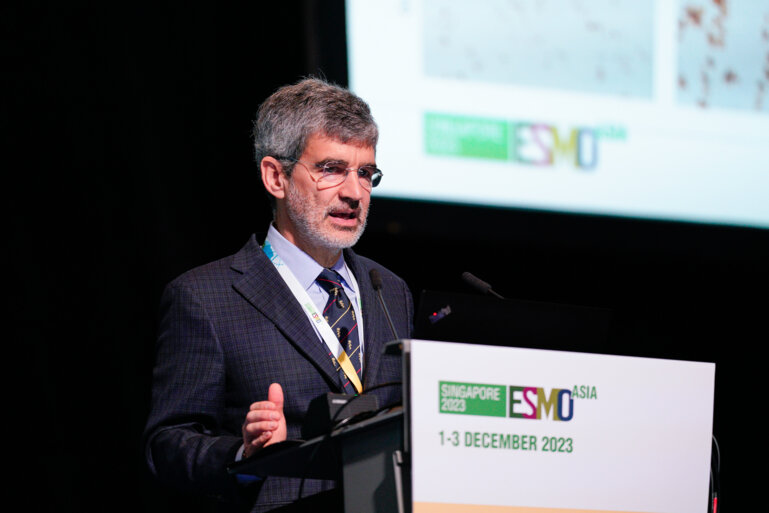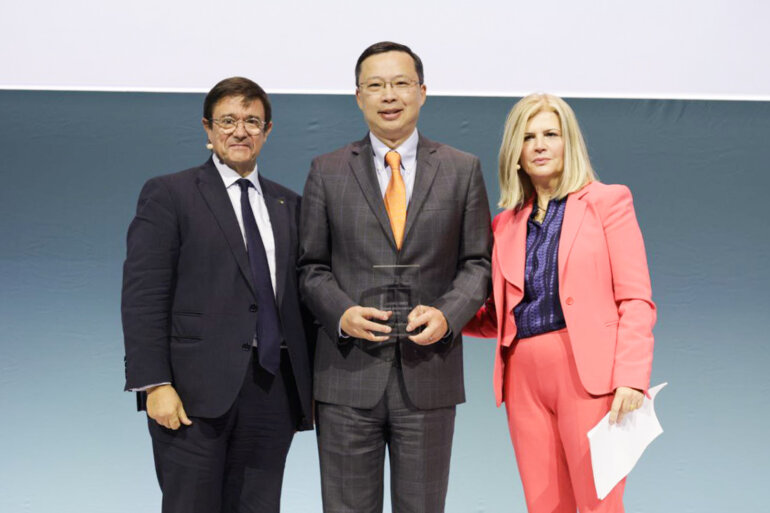Despite growing disappointing results from clinical trials, focus should now turn to the design of studies to better reflect tumour heterogeneity
Having revolutionised the treatment of many cancers, the indications for, and therapy combinations with immunotherapy must be better defined in the curative setting for patients with head and neck cancer. In recent studies, pembrolizumab plus chemoradiotherapy followed by pembrolizumab as maintenance therapy showed no significant improvement in event-free survival (EFS) over chemoradiotherapy alone in molecularly unselected head and neck squamous cell carcinoma (HNSCC) in the KEYNOTE-412 trial (Lancet Oncol. 2024;25:572–587). Furthermore, no progression-free survival (PFS) advantage was observed with the addition of avelumab to chemoradiotherapy followed by avelumab maintenance in patients with HNSCC in the Javelin-100 trial (Lancet Oncol. 2021;22:450–462). Abstract presentations at the ESMO Congress 2025 (Berlin, 17–21 October) add to the long list of negative trials in the field.
In the CompARE phase III trial, the addition of neoadjuvant and adjuvant durvalumab to chemoradiotherapy did not enhance the benefit of chemoradiotherapy in patients with oropharyngeal cancer (Abstract 1317O).
While the study found no discernible difference in 3-year overall survival (OS) rates with or without immunotherapy in the overall study population – 85% of whom had intermediate-risk, human papillomavirus (HPV)-positive disease – the results did point to an advantage of immunotherapy for patients with high-risk, HPV-negative disease. A key issue with the design of many clinical trials is that head and neck cancer is often considered one disease, but it is clear that HPV-positive and HPV-negative disease are distinct cancers with important clinical and biological differences, which significantly influence outcome after immunotherapy. Beside the fact that response to chemoradiotherapy is already high in HPV-positive tumours, it is important to note that these tumours are located in a completely different microenvironment and have lower tumour mutational burden (TMB), which generally portends an inferior response to immunotherapy.
Not surprisingly, the addition of pembrolizumab to cisplatin-based chemoradiotherapy compared with chemoradiotherapy alone in patients with locally-advanced HNSCC showed no significant improvement in EFS (HR 0.812; 95% CI 0.487–1.353; p=0.423) or OS (HR 0.832; 95% CI 0.453–1.529; p=0.554) in the phase IIb ADRISK trial (Abstract 1320O): again, the heterogeneous nature of the population, which included those with HPV-positive and -negative disease and pathologic high and intermediate risk, represented a caveat. Recently, the GORTEC 2018-01 phase III trial showed increased disease-free survival (DFS) with adjuvant nivolumab added to chemoradiotherapy in a selected patient cohort with resected high-risk HNSCC and nearly exclusively HPV-negative disease (J Clin Oncol. 2025;43(Suppl):LBA2).
The choice of antibody may also be crucial. Durvalumab is a PD-L1 inhibitor and, to date, studies involving this agent have tended to show a lack of superior efficacy to standard treatment. In the EAGLE study, durvalumab administered alone or in combination with the CTLA-4 inhibitor tremelimumab, did not improve survival rates over the EXTREME regimen (Ann Oncol. 2020;31:942–950), while in the NRG-HN004 trial, cetuximab outperformed durvalumab in combination with radiotherapy (Lancet Oncol. 2024;25:1576–1588). Spanning several solid tumours, a meta-analysis of 91 studies suggests that PD-1 inhibitors are more effective for improving the objective response rate and duration of response compared with PD-L1 inhibitors (Front Oncol. 2021;11:562315).
Also, the choice of primary endpoint is an important factor when comparing outcomes between treatments. OS is certainly not the best indicator. Other studies, such as KEYNOTE-412, used EFS as their primary endpoint and it is only recently, after a median follow-up of ~74 months, that an EFS advantage was shown for the addition of pembrolizumab to chemoradiotherapy over chemoradiotherapy alone (hazard ratio [HR] 0.79; 95% confidence interval [CI] 0.65–0.96), with greater divergence of efficacy in patients with PD-L1 combined positive score ≥1 (median EFS 70.9 months versus 48.3 months, respectively) (J Clin Oncol. 2025;43(Suppl):6013–6013).
Also presented in Berlin were results from a phase III trial of adjuvant nimotuzumab, an EGFR-targeted antibody, plus cisplatin-based chemoradiotherapy in patients with resected stage III–IV HNSCC, showing no significant improvement in DFS (HR 0.94; 95% CI 0.70–1.25) or OS (HR 0.84; 95% CI 0.60–1.18) compared with chemoradiotherapy alone at ~61 months of follow-up (Abstract 1318O). Targeting EGFR in this setting is intended to act as cisplatin, as a radiosensitiser, with the difference that anti-EGFR agents do not prevent metastasis. Arguably, similar strategies were used previously and failed to show survival benefits over chemoradiotherapy alone in comparable patient populations in the RTOG 0522 study of cetuximab (J Clin Oncol. 2014;32:2940–2950) and the GORTEC 2017-01 (REACH) study of avelumab plus cetuximab (Ann Oncol. 2021;32(Suppl 5):S1310). There may be a place for EGFR inhibitors in the post-operative setting in patients with resected, intermediate-risk, HPV-negative HNSCC, where it was shown in the phase III NRG/RTOG-0920 study that cetuximab plus radiotherapy improved DFS, but not OS (J Clin Oncol. 2025;43:1474–1487).
While these studies will not have an impact on the treatment of patients with locally advanced HNSCC, they do point to a need for researchers to learn from the biology of the disease and change how we conduct clinical trials: to include homogeneous patient populations, such as those with HPV-negative disease only or for whom the PD-(L)1 status is known, for instance, as it is difficult to show a treatment effect in a mixed population. For instance, the phase II/III NRG-HN005 trial in patients with p16-positive, HPV-positive oropharyngeal cancer was stopped for futility when the addition of nivolumab or chemotherapy to 60 Gy radiotherapy failed to satisfy non-inferiority criteria compared with the RTOG 1016 regimen, owing to the very favourable outcomes of the latter with a 98% PFS rate at 2 years (Int J Radiat Oncol Biol Phys. 2024;120(Suppl):S2–S3). However, there are other ongoing trials of immunotherapy in HPV-positive head and neck cancer (ECOG-ACRIN EA3161 and KEYCHAIN), which may provide further insights. Recently, the KEYNOTE-689 trial demonstrated that the addition of neoadjuvant and adjuvant pembrolizumab to standard care significantly improved EFS at 36 months (57.6% versus 46.4% with standard care; HR 0.73; 95% CI 0.58–0.92; two-sided p=0.008) in patients with locally advanced, predominantly HPV-negative HNSCC (N Engl J Med. 2025;393:37–50) and the phase II DEPEND trial showed deep responses in 53% of patients after neoadjuvant nivolumab plus chemotherapy in patients with HPV-negative, locally advanced stage IVA–B HNSCC (JAMA Oncol. 2025;11:492–501). Both trials show encouraging results of neoadjuvant immunotherapy and could be used as a foundation for further successful research of immunotherapy in HNSCC.
Programme details:
Mehanna HM, et al. Results from CompARE phase III RCT: neoadjuvant durvalumab plus chemoradiotherapy (CRT) followed by adjuvant durvalumab immunotherapy (IO) vs CRT alone in intermediate and high-risk oropharyngeal cancer (OPC). ESMO Congress 2025 - Abstract 1317O
Iyer NG, et al. Phase III trial of adjuvant nimotuzumab plus cisplatin-based chemoradiotherapy in resected stage III/IV head and neck squamous cell carcinoma. ESMO Congress 2025 - Abstract 1318O
Dietz A, et al. Postoperative adjuvant radiochemotherapy with cisplatin (aRCH) vs. aRCH plus pembrolizumab in locally advanced head and neck squamous cell carcinoma (HNSCC): First data of the ADRISK trial. ESMO Congress 2025 - Abstract 1320O







